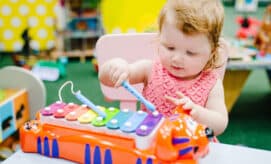When children sing along with different songs, they are engaging in foundational social-emotional skills like listening, patience, and coordinating with others.
Songs that use a “repeat-after-me” format, in which children listen and then repeat back what they’ve heard, invite children to pay close attention and practice turn-taking. Some musical games, such as freeze dance, also encourage children to listen and be still while they wait.
An article about musical play posted on NAEYC’s website points to the benefits of enjoying a variety of styles of music with children. Noticing and talking about the different beats and instruments featured in various styles of music like “classical, salsa, jazz, and folk,” encourages children to listen and engage.
Cooperating and Connecting with Peers
Singing and making music in group settings demonstrates the joy of cooperating and working alongside others.
Music also provides children an opportunity to celebrate their own heritage and culture while discovering and enjoying music from other cultures. Parents can be invited to share the names of songs their families listen to at home so that you and the children in your early learning program can listen to them together.
Musical Activity Ideas for Social and Emotional Learning
Incorporate Emotional Vocabulary
In a recent webinar, Pam Gittleman, educator and creator of the early learning organization, For Kinder Times, explained how the song Five Little Ducks can be used to promote emotional awareness, labeling feelings, expression, and regulation. She encourages educators to pause throughout the song and talk with children about what the ducks in the song might be feeling. For example, how might Mama Duck feel when she quacks and none of her ducks come back? And, how might the baby ducks feel when they see their mom again, at the end of the song?
This technique can be used with a variety of different songs. For example, how might the Itsy Bitsy spider feel when he gets knocked down by the rain, or when the sun comes out and he can climb again?
Use Music to Promote Mindful Awareness
In an article for Edutopia, Laura Petillo, a violinist and pre-k educator, and Kerry Carley Rizzuto, an associate professor of early childhood education at Monmouth University, share a mindfulness exercise using the jazz/bossa nova song “Águas de Março” (“The Waters of March”), by Brazilian songwriter Antônio Carlos Jobim. They offer the following instructions:
Start by encouraging children to find a relaxed position to listen to the song. They might want to lie down or sit in a cozy place. Before the song starts, have children take deep breaths and explain how the music can help them to relax their bodies: “When we feel calm, our bodies are relaxed. And when we’re relaxed, we can notice things we didn’t notice before. Let’s listen to this song and take deep breaths to become more mindful of our surroundings.”
After the song, encourage children to use their newly heightened focus to explore the classroom. Explain how their heightened awareness and relaxation will help them: “Now that we have calm and relaxed bodies, we can see things even better than we did before. Let’s go on a scavenger hunt to find the objects from the song in our room.” Students can go around the room to find objects mentioned in the song, such as a stick, a stone, a hairpin, and a flower.
This activity can be repeated with a variety of different songs that promote calm and relaxation.
Additional Resources
-
Nursery Rhymes for Kinder Times: a collection of updated Nursery Rhymes that nurture kindness and gratitude to support educators in facilitating conversations with young children about how to be kind, compassionate, and grateful.
-
Webinar with HiMama: A recent webinar that explores how music can be used in early learning classrooms to promote social-emotional learning.






